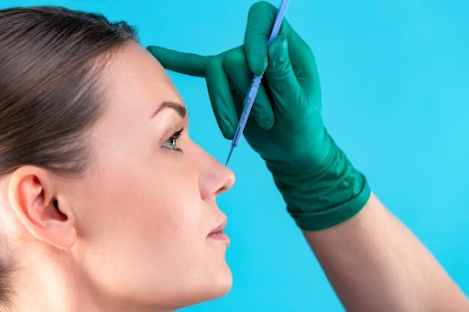Can Liquid Rhinoplasty Correct a Deviated Septum?
Liquid rhinoplasty, also known as non-surgical rhinoplasty, has gained popularity for its ability to enhance the appearance of the nose without invasive surgery. This procedure uses injectable fillers to alter the shape of the nose, offering a temporary solution for cosmetic adjustments. However, many individuals wonder if liquid rhinoplasty can address functional issues such as a deviated septum. In this comprehensive guide, we will explore whether liquid rhinoplasty can correct a deviated septum, the limitations of this procedure, and alternative treatments for septal deviation.
Understanding Liquid Rhinoplasty
What is Liquid Rhinoplasty?
Liquid Rhinoplasty in Dubai is a non-surgical cosmetic procedure that involves the injection of dermal fillers into the nasal area to reshape and enhance the nose. Commonly used fillers include hyaluronic acid and calcium hydroxylapatite. This procedure can smooth out bumps, lift the tip of the nose, and achieve other aesthetic improvements.
How Does Liquid Rhinoplasty Work?
During a liquid rhinoplasty, the practitioner injects filler material into specific areas of the nose to achieve the desired contour. The procedure typically takes about 15-30 minutes and is performed in an outpatient setting. Results are immediate, though the effects are temporary, usually lasting between 6 to 18 months depending on the type of filler used.
Can Liquid Rhinoplasty Correct a Deviated Septum?
What is a Deviated Septum?
A deviated septum occurs when the nasal septum, the cartilage and bone that divide the nasal cavity into two nostrils, is displaced from its normal position. This condition can lead to breathing difficulties, nasal congestion, and other functional problems. A deviated septum can be congenital or result from trauma.
The Limitations of Liquid Rhinoplasty for Septal Deviation
Liquid rhinoplasty is designed for cosmetic improvements rather than functional corrections. While it can effectively smooth out irregularities and enhance the appearance of the nose, it cannot address structural issues such as a deviated septum. Here’s why:
Structural Limitations: Liquid rhinoplasty only alters the surface appearance of the nose by adding volume. It does not change the underlying structure, which means it cannot correct the displacement of the septum or improve airflow through the nasal passages.
Functional Concerns: A deviated septum often causes functional problems such as nasal obstruction. Liquid rhinoplasty does not address these functional issues as it focuses solely on cosmetic enhancement.
Temporary Results: The results of liquid rhinoplasty are temporary, lasting between 6 to 18 months. Even if the procedure were to address a septal deviation temporarily, it would not provide a long-term solution to the functional issues.
Alternatives for Correcting a Deviated Septum
If you are experiencing functional issues due to a deviated septum, liquid rhinoplasty may not be the appropriate solution. Instead, consider the following alternatives:
Surgical Rhinoplasty
Surgical rhinoplasty, or traditional rhinoplasty, is a procedure designed to address both cosmetic and functional issues. During this surgery, the surgeon can correct a deviated septum by repositioning or reconstructing the septal cartilage and bone. This procedure can improve nasal airflow and address other structural issues. It is a more invasive option but provides long-lasting results.
Septoplasty
Septoplasty is a surgical procedure specifically aimed at correcting a deviated septum. The procedure involves straightening the septum and repositioning it to improve airflow and relieve nasal congestion. Septoplasty is typically performed under general anesthesia and may require a longer recovery period compared to liquid rhinoplasty. This procedure is effective for addressing the functional issues associated with a deviated septum.
Functional Rhinoplasty
Functional rhinoplasty combines elements of cosmetic and functional surgery. It is designed to address both aesthetic concerns and functional problems, such as a deviated septum. This type of surgery can improve nasal appearance while also correcting structural issues to enhance breathing.
Factors to Consider Before Choosing a Treatment
Assess Your Goals
Before choosing a treatment for a deviated septum, assess your primary goals. If your primary concern is functional, such as improved airflow and reduced congestion, surgical options like septoplasty or functional rhinoplasty may be more appropriate. If you are solely interested in cosmetic enhancement, liquid rhinoplasty can be a viable option, but it will not address underlying functional issues.
Consult with a Specialist
Consulting with an experienced specialist is crucial in determining the most appropriate treatment for your needs. A qualified plastic surgeon or ENT specialist can evaluate your nasal structure, discuss your concerns, and recommend the best course of action. They can also provide information on the benefits and limitations of each treatment option.
Consider Recovery and Risks
Each treatment option comes with its own set of risks and recovery times. Liquid rhinoplasty is minimally invasive with a quick recovery period, while surgical procedures involve longer recovery times and potential risks such as infection or scarring. Understanding these factors will help you make an informed decision about the best treatment for you.
Conclusion
While liquid rhinoplasty offers a non-surgical approach to enhancing the appearance of the nose, it is not a solution for correcting a deviated septum. Liquid rhinoplasty focuses on cosmetic improvements and cannot address the structural or functional issues associated with a deviated septum. For those experiencing functional problems due to septal deviation, surgical options such as septoplasty or functional rhinoplasty are more appropriate. Consulting with a qualified specialist will help you determine the best treatment based on your goals and needs.



Comments
Post a Comment